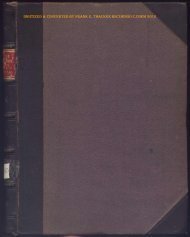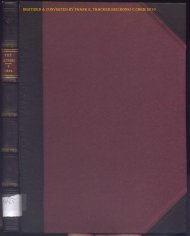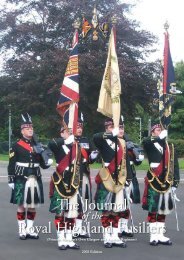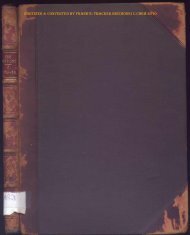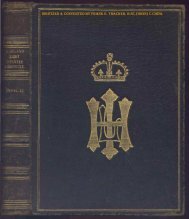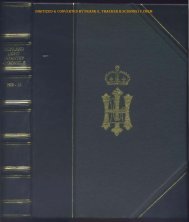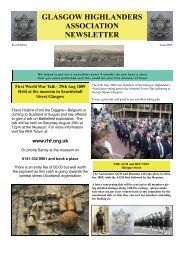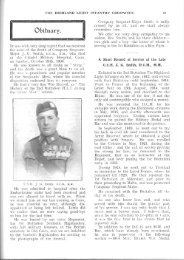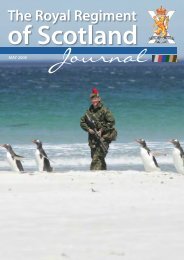HLI Chronicle 1909 - The Royal Highland Fusiliers
HLI Chronicle 1909 - The Royal Highland Fusiliers
HLI Chronicle 1909 - The Royal Highland Fusiliers
- No tags were found...
Create successful ePaper yourself
Turn your PDF publications into a flip-book with our unique Google optimized e-Paper software.
HIGHLAND LIGHT INFANTRY CHRONICLE.39<strong>The</strong> mention of tartan trews above nowleads to the desoription of the uniform w'ornby the Regiment during this oampaign.Although the Regiment was still dressedin the kilt, it does not seem to have been wornin Portugal; for what reason it was disoardedas a oampaigning dress does not appear, andthe 92nd, who were in the same brigade, appearto have worn it throughout the war. <strong>The</strong>dress is clearly portrayed in a oontemporarylit.hograph by Atkinson (a copy of whioh is inthe Offioers' Mess of the 1st Battalion), whichshows the Regiment charging at the Battle ofVimiera. <strong>The</strong>y wore the feather bonnet withthe red and white haokle of the period; shortskirtedcoa tee, whioh was laced across vrith theRegimental pattern of braid, which was whitevrith a red line in it. <strong>The</strong> trews were cut short,and tied in tight to the ankle, with shoes andgrey socks. Officers and men still wore longh!1ir, which was tied in a short club reachingto the base of the collar; but hair powder hadbeen discontinued as long ago as 1800.<strong>The</strong> Seventy-First were not destined, however,to remain long idle; the brief andbrilliant campaign just over, arduous as it was,was but a prelude to a far more trying wintercampaign. <strong>The</strong> Emperor Napoleon, duringthe summer of 1800, had been absent innorthern Europe, and at this time a campaignagainst Austria was imminent. He had, however,been successful in his main endeavourof securing the neutrality of Russia, whichmaterially lessened his difficulties in northernEurope. He therefore returned to Paris inOctober, and determined to devote his personalattention to the Peninsula, to crush theSpanish patriots and drive their British alliesfrom the country. For this purpose he calledout two conscriptions, to replace his defeatedveterans in Spain and to form a reserve;these two conscriptions each yielded a forceof 80,000 men.While Napoleon was thus vigorously pushingon his preparations the conduct of the BritishCabinet at home was marked by the greatestprocrastination and weakness. It was the6th of October before a dispatch containingthe first determinate plan of campaign arrivedin Lisbon. Thirty thousand infantry andfive thousand cavalry were to be employedin the north of Spain, where they were to cooperatewith the Spanish armies alreadythere. General Sir John Moore* was tocommand, and was authorised to unite thewhole, either by a voyage round the coast, orby a march through the interior. Sir Johnchose the latter alternative, determining to advancein person with the troops already atLisbon, and to form a juncture near Salamancawith the additional troops which were to arrivefrom England and to land at Corunna undercommand of General Sir David Baird.<strong>The</strong> difficulties which Sir John Moore hadto face were enormous. With the Frenchalready making their presence felt 011 theSpanish frontier, he had to organise his army,which was largely composed of raw troops,in a strange country already devastated bythe French, to procure the whole of the largeamount~f transport required for his force,the difficulty of which was further increasedby the fact that he was quite inadequatelysupplied with money from home. <strong>The</strong> roadswere very bad, and the rainy season (so balefulto troops) was at hand to further accentuatethe importance of pushing on without delayon a march of 300 miles before he could hopeto join up his army vrith Sir David Baird's.<strong>The</strong> latter was equally badly plaeed atCorunna, where he was without supplies ormoney to carry out hi" march of 200 miles.,. Sir .1ohn ~foore was born in Glasgow on November13, 1761, and was educated at the public school anduniversity of that city. He joined the Arm,V in 177(;as an Ensign in the iHst B.egiment, and afterwardsnistinguished himself in the West Jnd;es under BirRalph Abercromby, who chara~terised his conductas " the :.dmimtion of the Whole Army." He servedill the Irish Rebellion, in Holland in 1799, and inl~gypt in 18t) J, when 11(\ was twice wounded. He h~ dbeen seleded to instruct the newly formed LightInfantry Regiments in an improved system of drill,find may be deemed the .• Father of Light IufalltryRegiments." }~rave, chivalrous, ann high-spirited,and (ievoting himself to increasing the comfort of hismen, althol\gh a rigid disciplinarian, he Waf! universallyrespected and beloved by all who had thefortune to serve under him.



